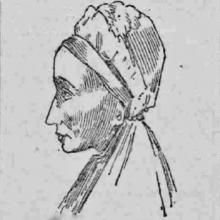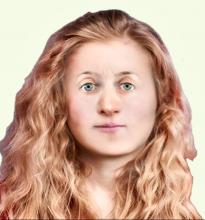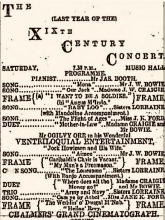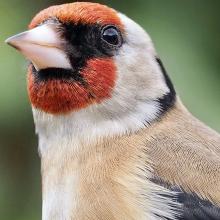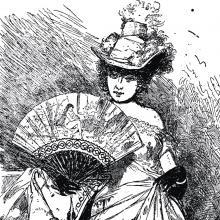
1844–46
ROBBERY AND RECOVERY OF PROPERTY.—Late on Friday night, a blacksmith, named Clark, from Elgin, allowed himself to be enticed into a disreputable house in Nottingham Terrace, by a woman named Beaton; but he had not been there many minutes, when he discovered himself minus a pocket book containing L.16.[1]
He gave the alarm, and the women in the house, to quiet him, restored his pocket book with five sovereigns in it. However, Clark had the whole inmates, five in number, and all females, brought to the Police Office—where, on being searched, two L.5 notes, and one L.1 note were found on the person of Agnes Duncan or Patterson, who passed as the servant of the house, which is kept by one Agnes Marshall or Grant.
The whole five were placed at the Police bar on Saturday, and the case was remitted to Mr Dymock, Procurator Fiscal for the city, for farther investigation.
Caledonian Mercury, 15 April 1844
[1] About £967 today, or 80 days’ wages for a skilled tradesman in 1844.
*****
The workmen in the large establishment of Messrs J. Cochrane & Co. brassfounders, Greenside Lane, have, by working an extra hour for ten days, at the suggestion of their employers, been enabled to contribute to the funds of the Royal Infirmary no less a sum than seven pounds.[2]
Caledonian Mercury, 24 June 1844
[2] About £423 today, or 35 days’ wages for a skilled tradesman in 1844.
*****
Mr HALL’S LECTURES ON PHRENO-MESMERISM—On Saturday and Monday, we again attended Mr Hall’s demonstrations.
The exhibition on both occasions was in its main features nearly similar to those already noticed—the patients being mesmerised, and the effects of music, both of a sad and lively character, shown upon them. To those who have not perfect confidence in the integrity of the experimenter, this part of the exhibition is not calculated to carry a favourable impression of the new science, and a good deal of scepticism is generally the result.
A different result, however, attends the demonstrations in animal magnetism. On the present occasion, on a request from Mr Hall that any person amongst the audience who had been formerly mesmerised might come to the platform, a stranger lad (a printer with Mr Reid, Nottingham Place) presented himself. The experimenter asked him to grasp a stick firmly, which he did, and then requested him to let it fall. The boy declared that the stick was firmly clenched in his hand, but having touched his wrist with a finger of the other arm, the stick immediately fell. The arm, however, continued extended, and the fingers of the hand which had held the stick were stretched out and rigid, and he declared that to close his hand was impossible. In explanation of his being able to let the stick drop, the lad stated that on one occasion a similar experiment had been tried with him by a person who could not bring the arm back to its natural position.
Another experiment of the same kind followed. The lecturer having planted himself firmly on the platform, the boy instinctively imitated him, and on being called to move forward, he could not stir. To test this immoveability, Mr Hall laid a pound-note on the end of the platform,[3] and another gentleman (Mr Gray, of the North British Advertiser) put a quantity of silver along with it, as a temptation to the boy. The latter struggled hard to seize the tempting prize, and in his efforts fell on the platform. Mr Hall then said he might roll to the money, if he chose; but on the experimenter making passes with his hands in an opposite direction, the boy actually rolled, apparently in great agony, to the other end of the platform.
A number of other experiments of a like nature, testing the extraordinary sympathetic and attractive force possessed by the lecturer over this and other persons, were also gone through, apparently much to the satisfaction of the numerous audience. His farewell lecture takes place this evening.[4]
Scotsman, 9 October 1844
[3] About £60 today, or 5 days’ wages for a skilled tradesman in, 1844.
[4] Phreno-mesmerists claimed that entranced patients, when touched on the relevant bumps of the head, would behave in specific ways.
The Phrenological Journal, and Magazine of Moral Science, for the Year 1845 (Vol. XVIII, p.92) reported—‘Since our last publication, Mr Spencer T. Hall has paid two visits to Edinburgh, holding on both occasions several numerously and respectably attended conversazioni, in the large Waterloo Room. The same phenomena were exhibited as he had previously shewn in Glasgow (see ante, xvii, 414); of the genuineness of the chief of them, we find, after witnessing three exhibitions, no room for doubt. Such of the experiments as were performed on persons unknown to Mr Hall, were, of course, the most satisfactory to the spectators.
'What struck us forcibly was the circumstance, that although in all phreno-mesmeric cases we had previously seen, the activity of the mental faculties ceased the moment the operator’s finger was withdrawn from the head, this seldom if ever happened with Mr Hall’s subjects, by whom the faculties continued to be displayed when contact no longer existed. Of his numerous “new organs,” very little was said.
'We may add, that although his prelections were not in all respects suitable to the taste of a cultivated audience, and the style of his advertisements was little calculated to prepossess the public in his favour, Mr Hall has left a favourable impression of his moral and intellectual character, and zeal in the pursuit of truth. While here, he experimented in private as well as in public, and copious reports of the results may be seen in several Numbers of the Supplement to theNorth British Advertiser, and in the Scotsman of 16th October. We are glad to learn that he intends to go through a course of medical study.’
*****
DEATH BY BURNING.—On Thursday night, about five o’clock, Margaret Hutchison, wife of John Hutchison, mason, Simpson’s Court, Greenside, was found burned to death in her own house. She was a decent elderly woman, and appears to have been sleeping near the fire, and not to have awakened till the flames made such progress as to render her incapable of calling for assistance. The neighbours had their attention directed to her condition by the smell of fire. The body presented a shocking spectacle.
Caledonian Mercury, 30 December 1844
*****
SALE OF HORSES, &c.—HALLOW FAIR.
______________
MR WORDSWORTH, of Her Majesty’s Repository,[5] Nottingham Place, Edinburgh, begs to intimate that he will, as usual, have TWO SALES by AUCTION in Hallow Fair Week, viz. on Wednesday the 12th and Thursday the 13th November next, commencing each day at Twelve o’clock precisely, when a number of Valuable HORSES, CARRIAGES, &c., will be sold, consisting principally of HUNTERS and CARRIAGE HORSES, besides several good HACKS and GIG HORSES, CHARIOTS, PONY PHAETONS, GIGS, &c.,[6] the Property of different Gentlemen, who, having no further use for them, have consigned them to Mr Wordsworth’s Establishment for sale in the above week—full particulars of which will be given in a future advertisement and catalogue.
Noblemen, Gentlemen, and others, having HORSES for SALE, will find the above an excellent opportunity for disposing of them, and Mr. W. will be ready in the meantime to receive instructions about any Horse or Horses for Sale; and the earlier he is furnished with the requisite information the better, to enable him to make his arrangements accordingly.
No Auction Duty. Commision on Sales 5 per cent. If not sold, 5s. for exposing.
Scotsman, 1 November 1845
[5] At the southern end of the street, Wordsworth’s ‘Horse Bazaar’ figures in the 1852 OS map. A Horse Repository is still marked there in the 1893 map.
[6] Hack—workaday horse. Chariot—light, 4-wheeled carriage with a coach box and back seats only. Phaeton—minimal, lightly sprung carriage with 4 large wheels, drawn by 1 or 2 horses. Gig—light, 2-wheeled carriage pulled by 1 horse. See entry for 28 September 1857.
*****
EDINBURGH:—Printed for the Proprietors, by A. CANNON (residence, 4, Old Broughton), at 12, EAST ROSE LANE, and Published by him, every Wednesday and Saturday Morning, at No. 27, SOUTH HANOVER STREET, where all communications (Post-paid) must be sent.
Price of a single paper 4½d; or on the following terms of subscription:—On credit, one year, £2, 4s; quarter, 11s. If paid in advance, one year, £2, quarter, 10s 6d.[7]
Edinburgh Evening Post and Scottish Standard, 21 February 1846
[7] These words appeared at the foot of the paper's fourth and final page. It seems to have run from about 1844 to 1849, but more research on this is needed.
*****
BELLEVUE HOUSE.—This building, better known as the Custom-house, and more recently occupied as the Excise Office, is just about to be numbered among “the things that were,” as in a few days it will be levelled with the ground.
Within these forty years past, Bellevue House, originally the mansion of General Scott, the father-in-law of Mr Canning, and one of the most successful gamblers of the age, stood in the middle of a beautiful lawn, sheltered by belts of planting, and no human habitation nearer it than the villages of Canonmills and Stockbridge on the north and west, and Old Broughton and Duke Street on the east and south.
In the year 1805, there was only one solitary house of the New Town, north of the fine terrace of Queen Street built, and that stood in Abercromby Place. We remember on occasion of the illumination for the victory of Trafalgar, seeing two porters standing with flambeaux, guarding this commencement of the northern division of the New Town.
The removal of Bellevue House will be a great improvement to Drummond Place, besides opening up the vistas from Duke Street northward and London Street eastward.
Edinburgh Evening Post and Scottish Standard, 25 February 1846
*****
THERE ARE “TWO THINGS ALIKE.”—Under this title, in September 1841, we noticed the circumstances of twin sisters, the children of a respectable family residing at Skateraw, near Dunbar, who were then about four years of age, and who from their birth had been in form, feature, voice, &c. so strikingly alike, that even their mother could only distinguish between them by placing an external mark on one of them.
The two girls are now about nine years of age, beautifully fair—in manner and speech and every thing so exactly the same, that it is impossible for any one, not acquainted with the mark, to say which is Anne and which Elizabeth. We had the pleasure of seeing these interesting girls the other day, and of proving the accuracy of what we have attested.
They are nieces of Mr Greenlaw, in Gabriel’s Road, and have been for some time here on a visit to their uncle.
Caledonian Mercury, 19 March 1846
*****
SWINTON ROW, ELDER STREET.
Mr ADAM has Resumed his CLASSES.—
DAY SCHOOL.
English, with Collateral Branches, including Writing, Arithmetic, and Singing, per Quarter, 7s. 6d.;[7] Drawing, 3s. extra; Latin or French, 3s. extra; Needlework for the Girls, 1s. 6d. extra; Writing Materials, 1s. 6d extra.
EVENING SCHOOL
For Writing and Arithmetic, per Qr, 7s. 6d.
Hours for Young Ladies, from 5 till 7.
… for Young Men, from 7 till 9.
Scotsman, 26 September 1846
[7] About £30 today, or 1 days’ wages for a skilled tradesman in 1846. In 1858–59, the Edinburgh & Leith Post Office Directory lists Mr Adam’s School at 27 St James’ Sq. Quarterly fees (payable in advance) ranged between 10s. and £15s.
Image top-right: Wikimedia, creative commons
